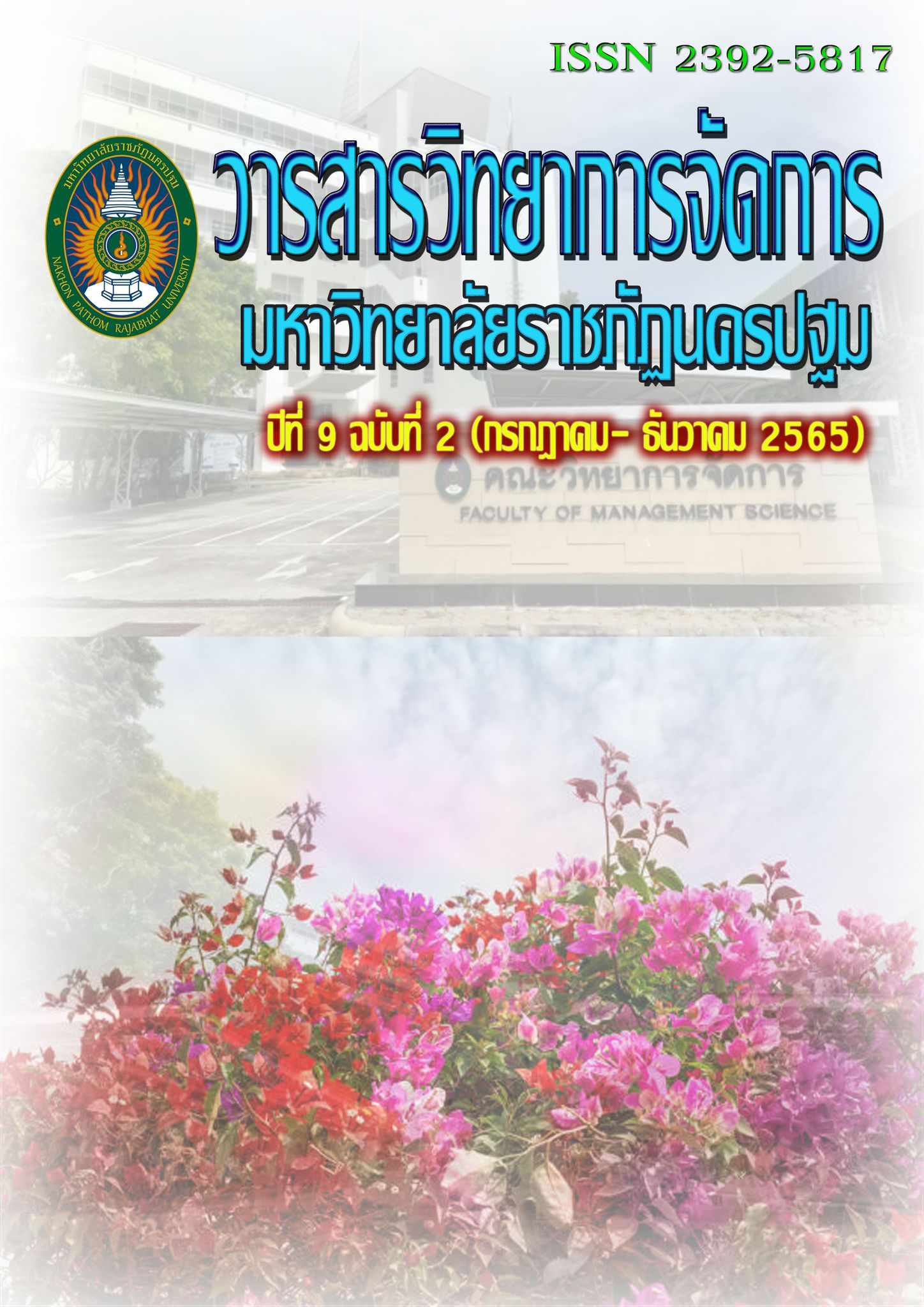ผลกระทบของระเบียบด้านสิ่งแวดล้อมต่อประสิทธิผลขององค์กรภาคธุรกิจ ภายใต้รูปแบบเศรษฐกิจแนวคิดใหม่ (BCG Economy) ของไทย
Main Article Content
บทคัดย่อ
งานวิจัยครั้งนี้ มีจุดมุ่งหมายเพื่อ 1) ศึกษากระบวนการเปลี่ยนแปลงเชิงทฤษฎีและวิจัยสภาพปัจจุบันของผลกระทบของระเบียบด้านสิ่งแวดล้อมต่อประสิทธิภาพขององค์กรภาคธุรกิจภายใต้รูป แบบเศรษฐกิจแนวคิดใหม่ (BCG Economy) ของไทย 2) สร้างรูปแบบจําลองทางทฤษฎีว่าด้วยระเบียบ ด้านสิ่งแวดล้อม กลยุทธ์การแข่งขันขององค์กรภาคธุรกิจ และประสิทธิภาพขององค์กรภาคธุรกิจ 3) ตรวจสอบเพื่อยืนยันมุมมองที่มีพื้นฐาน มาจากการรับมือกลยุทธ์การแข่งขันขององค์กรภาคธุรกิจ และความสัมพันธ์ด้านผลกระทบของระเบียบด้านสิ่งแวดล้อมต่อประสิทธิภาพขององค์กรภาคธุรกิจ 4) เสนอข้อคิดเห็นรูปแบบเศรษฐกิจแนวคิดใหม่ (BCG Economy) ของไทย เป็นกลยุทธ์การแข่งขันและประสิทธิภาพขององค์กร ทำให้ประเทศไทยบรรลุสิ่งแวดล้อมและเศรษฐกิจแบบ “ได้ประโยชน์ร่วมกัน” และส่งเสริมรูปแบบเศรษฐกิจแนวคิดใหม่ไทยไปยังประเทศต่าง ๆ มากขึ้น
ผลวิจัยพบว่า 1) รูปแบบการใช้คําสั่งควบคุมของระเบียบด้านสิ่งแวดล้อม ไม่มีผลกระทบต่อความได้เปรียบในการแข่งขันขององค์กรภาคธุรกิจ 2) รูปแบบแรงจูงใจทางการตลาดและการดําเนินงานด้านระเบียบด้านสิ่งแวดล้อมอย่างเต็มใจ มีผลกระทบเชิงบวกค่อนข้างมากอย่างมีนัยสําคัญต่อความได้เปรียบในการแข่งขันขององค์กรภาคธุรกิจ 3) รูปแบบแรงจูงใจทางการตลาดด้านระเบียบด้านสิ่งแวดล้อม มีผลกระทบทิศทางบวกต่อกลยุทธ์ต้นทุนต่ำสูงมากอย่างมีนัยสําคัญถึงร้อยละ 70.4 และการดําเนินงานด้านระเบียบสิ่งแวดล้อมอย่างเต็มใจต่อกลยุทธ์ความแตกต่างของความได้เปรียบในการแข่งขันขององค์กรภาคธุรกิจ มีผลกระทบทิศทางบวกอย่างมีนัยสําคัญสูงถึงร้อยละ 48.8 และ 4) ความได้เปรียบในการแข่งขันด้านความแตกต่างขององค์กรภาคธุรกิจ ส่งผลกระทบทิศทางบวกชัดเจนอย่างมีนัยสําคัญต่อประสิทธิภาพขององค์กรภาคธุรกิจสูงถึงร้อยละ 56.2 และ 52.8
ยังพบอีกว่า ผลวิจัยเชิงทฤษฎีและผลวิเคราะห์เชิงประจักษ์นี้ นําเสนอสิ่งใหม่ภายใต้รูปแบบเศรษฐกิจแนวคิดใหม่ โดยใช้ระเบียบการควบคุมเศรษฐกิจมหภาคแห่งชาติ และการดําเนินการขององค์กรภาคธุรกิจ เกิดผลกระทบต่อเนื่องคือ 1) นโยบายระเบียบด้านสิ่งแวดล้อมและแผนกลยุทธ์การแข่งขันขององค์กรภาคธุรกิจสมบูรณ์ 2) ประสิทธิภาพนโยบายระเบียบด้านสิ่งแวดล้อมด้วยเศรษฐกิจแนวคิดใหม่ เป็นกลยุทธ์การแข่งขันที่ทำให้องค์กรภาคธุรกิจบรรลุผลลัพธ์ทางการเงิน และ 3) การเผยแพร่ด้านนโยบายระเบียบด้านสิ่งแวดล้อมด้วยเศรษฐกิจแนวคิดใหม่ของประเทศไทยโดยใช้พื้นฐานทางทฤษฎีอย่างมีประสิทธิภาพสร้างแนวทางใหม่ในอนาคตสู่ต่างประเทศ
* หลักสูตรบริหารธุรกิจ มหาวิทยาลัยกรุงเทพธนบุรี กรุงเทพฯ 10170
Corresponding author: money753@163.com
Article Details

อนุญาตภายใต้เงื่อนไข Creative Commons Attribution-NonCommercial-NoDerivatives 4.0 International License.
ทัศนะและข้อคิดเห็นของบทความที่ปรากฏในวารสารฉบับนี้เป็นของผู้เขียนแต่ละท่าน ไม่ถือว่าเป็นทัศนะและความรับผิดชอบของกองบรรณาธิการ
เอกสารอ้างอิง
Anderson, J. and Bausch, C. (2006). Climate change and natural disasters: Scientific evidence of a possible relation between recent natural disasters and climate change. Policy Department Economic and Scientific Policy, 2, 2. https://www.europarl.europa.eu/meetdocs/2004_2009/documents/dv/ieep_cc_natural_disasters_/ieep_cc_natural_disasters_en.pdf
Arifwidodo S D and Tanaka T. (2015). The Characteristics of Urban Heat Island in Bangkok, Thailand,. Procedia Social & Behavioral Sciences, 195: 423-428.
Blackman, A., Li, Z., & Liu, A. A. (2018). Efficacy of command-and-control and market-based environmental regulation in developing countries. Annual Review of Resource Economics, 10, 381-404.
Circle Economy (2019). The Circularity Gap Report. Circle Economy, Amsterdam. Retrieved May 20, 2020. https://docs.wixstatic.com/ugd/ad6e59_ce56b655bcdc4f67
ad7b5ceb5d59f4
Dong J, Xue G, Dong M, et al. (2015). Energy-saving power generation dispatching in China: Regulations, pilot projects and policy recommendations — A review,. Renewable and Sustainable Energy Reviews, 43:1285-1300.
Entwisle B, Rindfuss R R, Walsh S J, et al. (2008). Population growth and its spatial distribution as factors in the deforestation of Nang Rong, Thailand, Geoforum, 39(2): 879-897.
Feng Yunke. (2012). Research on the Influence Mechanism and Policy System of Enterprise Environmental Technology Innovation Dissertation. Henan University of Technology.
Frondel M, Horbach J,and Rennings. K. (2007). End‐of‐pipe or cleaner production? An empirical comparison of environmental innovation decisions across OECD countries, Business Strategy and the Environment, 16(8):571-584.
López-Gamero M D, Molina-Azorín J F and Claver-Cortés E. (2010). The potential of environmental regulation to change managerial perception, environmental management, competitiveness and financial performance, Journal of Cleaner Production, 18(10):963-974.
Ma Shiguo. (2008). Selection and Implementation of Environmental Regulation Tools:
A Review,. World Economics and Literature, 2008(3):76-90.
Milliman S R and Prince R. (1989). Firm incentives to promote technological change in pollution control, Journal of Environmental Economics and Management, 17(3):247-265.
Nakao Y, Amano A, Matsumura K, et al. (2007). Relationship between environmental performance and financial performance: an empirical analysis of japanese corporations,. Business Strategy and the Environment, 16(2):106-118.
Office of the National Economic and Social Development Board, Office of the Prime Minister. (2018). The Twelfth National Economic and Social Development Plan[M]. Bangkok: Office of the National Economic and Social Development Board (NESDB); Office of the Prime Minister, 2018: 1-11.
Palmer K, Oates W E, Portney P R. (1995). Tightening environmental standards: the benefit-cost or the no-cost paradigm?,. Journal of Economic Perspectives, 9(4):119-132.
Porter M E, and Linde C. (1995). Toward a New Conception of the Environment-Competitiveness Relationship,. Journal of Economic Perspectives, 9(4):97-118.
Porter M. (1980). Competitive strategy : techniques for analyzing industries and competitors : with a new introduct. Free Press.
Rapport D J, Costanza R, and Mcmichael A J. (1998). Assessing ecosystem health, Trends in Ecology & Evolution, 13(10): 397-402.
Ruchirawat M, Settachan D, Navasumrit P, et al. (2007). Assessment of potential cancer risk in children exposed to urban air pollution in Bangkok, Thailand, Toxicology Letters, 168(3): 200-209.
Seul Gi Yoo, Kyung Do Han, Kyoung Hwa Lee, Yeonju La, Da Eun Kwon and Sang Hoon Han. (2019). Impact of Cytomegalovirus Disease on New-Onset Type 2 Diabetes Mellitus: Population-Based Matched Case-Control Cohort Study. Diabetes Metab J, 43, 815-829.
Singlor, T. (2021). When the world need 'new economy model' thus BCG policy is the national agenda of Thailand in 2021. Retrieved May 10, 2022. Form https://www.sdgmove.com/2021/04/14/bcg-economy-model-trend-th-national-agenda-2021/
Steininger K W, and Weckhannemann H. (2002). Global Environmental Change In Alpine Regions,. Carbon, 49(3): 838–843.
The Office of National Higher Education Science Research and Innovation Policy Council (NXPO). (2021). BCG in Action Retrieved May 10, 2022. Form. https://www.nxpo.or.th/th/en/bcg-in-action/
Wang K, Yu S, and Zhang W. (2013). China’s regional energy and environmental efficiency: A DEA window analysis based dynamic evaluation, Mathematical and Computer Modelling, 58(5):1117-1127.
Wang Liping and Song Jiaojiao. (2011). A review of the research on the relationship between domestic and foreign environmental regulation and enterprise competitiveness, Resource Development and Market, 27(2):154-156.
World Bank Institute for Health Metrics and Evaluation. (2016). The cost of air pollution: strengthening the economic case for action. Washington, DC: World Bank, 2016: 11-75.
Yamane, T. (1973). Statistics: an introductory analysis. New York: New York: Harper & Row.
Zhang Cheng, Lu Yang, Guo Lu, et al. (2011). Environmental regulation intensity and production technology progress, Economic Research, 2011(02):113-124.
Zhao X, Zhao Y, Zeng S, et al. (2015). Corporate behavior and competitiveness: impact of environmental regulation on Chinese firms, Journal of Cleaner Production, 86:311-322.


